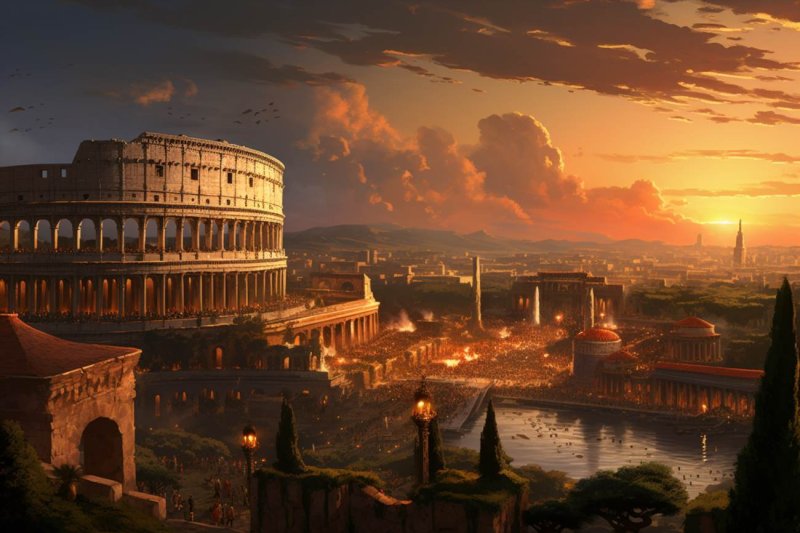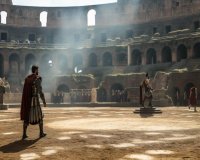Legacy of Ancient Rome: From Gladiators to Emperors

The Legacy of Ancient Rome: From Gladiators to Emperors
Rome, the eternal city, has a legacy that extends far beyond its present-day existence. From the grandeur of the Colosseum to the enduring influence of Roman law, the legacy of ancient Rome continues to shape our world in many ways.
Roman Architecture and Engineering
One of the most striking aspects of Rome's legacy is its architectural and engineering prowess. The Roman Empire was known for its grand construction projects, including aqueducts, roads, and monumental structures. The Colosseum, an iconic symbol of Rome, stands as a testament to Roman engineering, and it continues to inspire awe and wonder in the modern era.
The Colosseum: Home of Gladiatorial Combat
The Colosseum, also known as the Flavian Amphitheatre, was a hub of entertainment and bloodshed. Gladiatorial combat, where skilled fighters battled to the death, was a central spectacle in Roman society. These brutal contests were held in the Colosseum, and they left an indelible mark on the popular image of ancient Rome.
|
Gladiators
|
Emperors
|
|
Gladiators were typically slaves, prisoners of war, or criminals forced to fight for their lives in the arena. They were trained in combat techniques and often became celebrated figures in Roman society.
|
Emperors, the rulers of the Roman Empire, held immense power and influence. The decisions of emperors shaped the course of history and had a profound impact on the Roman legacy.
|
Roman Emperors: Shaping History
The Roman emperors, from Augustus to Nero, played a pivotal role in the history of Rome. They wielded immense power and authority, often shaping the destiny of the empire through their policies, military conquests, and governance.
The Spread of Roman Culture
One of the enduring legacies of ancient Rome is the spread of Roman culture and language. Latin, the language of the Romans, served as the foundation for many modern Romance languages, including Italian, French, Spanish, and Portuguese. Roman culture, with its emphasis on art, literature, and philosophy, laid the groundwork for many aspects of Western civilization.
Roman Law: A Lasting Influence
Roman law, with its principles of justice and equality, has left an indelible mark on legal systems worldwide. The Roman concept of "ius civile" (civil law) laid the foundation for modern legal thinking. Concepts like the presumption of innocence and contracts have their roots in Roman legal principles.
The Fall of Rome
Despite its grandeur, the Roman Empire eventually succumbed to internal strife, external threats, and economic challenges. In 476 CE, the last Roman emperor was overthrown, marking the end of the Western Roman Empire. The fall of Rome led to the fragmentation of Europe and the onset of the Middle Ages.
Conclusion
The legacy of ancient Rome is a complex and multifaceted one. From the awe-inspiring architecture of the Colosseum to the enduring influence of Roman law, Rome's impact on the world is undeniable. Even today, we see echoes of ancient Rome in our culture, language, and legal systems, making it a civilization that truly shaped the course of history.
Rome Gladiator School Experience
Discover the thrill of ancient Roman combat at the Rome Gladiator School, located on the historic Via Appia Antica. This engaging 2-hour workshop offers a unique opportunity for both adults and children to step into the shoes of a gladiator and learn the art of sword fighting.
Upon arrival, participants don authentic gladiator tunics and delve into the fascinating world of Roman history. The experience begins with a guided tour of the museum, where an impressive collection of gladiatorial artifacts provides valuable insights into the life of these legendary fighters.
Under the expert guidance of instructors fluent in both English and Italian, attendees learn the fundamental techniques of gladiatorial swordplay. The training session is not just educational but also a great physical workout, providing a unique and immersive way to explore ancient Roman culture.
During the workshop, participants receive a comprehensive overview of gladiator life in Ancient Rome, including valuable tips on mastering Roman weapons. The engaging narrative paints a vivid picture of the challenges and triumphs faced by gladiators, adding depth to the experience.
At the end of the session, participants receive a certificate as a testament to their newfound skills and knowledge. The combination of historical immersion, physical activity, and expert guidance makes this Gladiator School experience a must-try activity in Rome.
Meeting Point: Meet your instructor at the Gladiator School of Rome, conveniently located on the Appian Way. The nearest bus station is Appia Antica-Travicella (lines 118 or 218).
Important Information: Parents and/or companions accompanying participants do not need to pay for a ticket if they do not attend the course.
Customer Reviews: With an impressive overall rating of 4.7 out of 5 based on 415 reviews, visitors rave about the knowledgeable guides, engaging activities, and the immersive learning experience.
Gladiators: Symbols of Bravery and Entertainment in Rome
In the heart of ancient Rome, amidst the grandeur of the Colosseum, gladiators stood as symbols of both bravery and entertainment. These warriors captivated the Roman world with their combat skills and heroism, creating a legacy that endures to this day.
Gladiators were more than just combatants; they were larger-than-life figures who filled the Roman amphitheaters with excitement and spectacle. Let's delve into the fascinating world of gladiators and their roles in Roman society.
The Origin of Gladiators
The roots of gladiatorial combat can be traced back to Etruscan and Samnite funeral rituals. Originally, these games were intended to honor the deceased, with warriors engaging in combat as a form of sacrifice. Over time, this practice evolved into public spectacles that entertained the masses.
Training and Types of Gladiators
Gladiators underwent rigorous training in specialized schools called "ludi." They honed their combat skills with weapons such as swords, tridents, and nets. There were various types of gladiators, each with its distinctive equipment and fighting style. Some well-known types include:
| Type of Gladiator |
Weapons |
Fighting Style |
| Samnite |
Sword and Shield |
Aggressive and versatile |
| Retiarius |
Trident and Net |
Quick and agile |
| Secutor |
Gladius and Shield |
Focused and heavily armored |
Gladiators in the Arena
The Colosseum, with its seating for over 50,000 spectators, was the epicenter of gladiatorial combat. Gladiators faced each other or fought exotic animals, providing a unique form of entertainment for the Roman populace. These battles were not only about physical prowess but also about displaying bravery and honor.
Gladiators who displayed exceptional skill and courage often earned the adoration of the crowd. Some, called "auctorati," were even able to negotiate for their release from the ludus. These victorious gladiators became celebrities in their own right, symbolizing the ideals of courage and resilience.
The Legacy of Gladiators
While gladiatorial combat eventually fell out of favor with the decline of the Roman Empire, the legacy of these brave warriors lives on. They continue to inspire us, representing the enduring human spirit in the face of adversity. Gladiators were not just entertainers; they were symbols of strength, bravery, and the indomitable will to triumph.
Today, when we think of Rome, we can't help but conjure images of these iconic figures, immortalized in the sands of the Colosseum. Gladiators remain a testament to the complex nature of Roman culture, where entertainment and heroism intertwined, leaving a lasting mark on history.
Rome: Gladiator Show and Museum Experience
Step into the ancient world with an exclusive ticket to witness a captivating gladiator fight in a unique Roman location. Surrounded by atmospheric music, dazzling lights, and immersive visual effects, you'll be transported into the heart of Roman history.
About this Ticket:
- Free cancellation available - Cancel up to 24 hours in advance for a full refund.
- Reserve now & pay later - Keep your travel plans flexible by booking your spot with no upfront payment.
- Duration: 1.5 hours
Experience Highlights:
- Immerse yourself in the ancient atmosphere of a real Roman gladiator fight.
- Witness originality through ancient dances, Vestals rites, and pantomime.
Gladiator Show of Ancient Rome:
The event unfolds in the Gladiators' headquarters, just 3.5 km from the Colosseum. In an impressive arena filled with music, lights, and effects, you'll witness a thrilling gladiator fight, along with ancient dances, Vestals rites, and pantomime. The show is executed by historical reenactors using authentic weapons and armor, allowing you to capture memorable moments through photographs.
Event Schedule:
- Entrance at 20:45
- Visit the "Museo storico - didattico del legionario romano" and enjoy a cocktail in the Armory of the Legion.
- Event concludes around 22:00
Show Dates 2022:
Every Friday from May 13 to September 16, 2022.
Includes:
Admission to the museum and the captivating gladiator show.
Meeting Point:
Look for Rome Gladiator School - 'Gruppo Storico Romano'.
Customer Reviews:
Rated 4.4/5 based on 76 reviews. Visitors praise the professionalism of the show, its suitability for all ages, and the included snacks and drinks. Some recommend accessing the venue by metro or bus for convenience.
Don't Miss Out:
Book your spot now and relive the glory of ancient Rome!
Emperors of Rome: Rulers of the Known World
The history of Rome is intricately tied to its emperors, who reigned as the most powerful individuals in the ancient world. These rulers of the known world held tremendous influence over not just Rome but also vast territories, shaping the course of history for centuries. This article delves into the emperors of Rome and their significant contributions to this remarkable civilization.
The Rise of the Roman Empire
The Roman Empire, at its height, spanned three continents and controlled an empire that encompassed a diverse range of cultures, languages, and peoples. Its journey began as a republic, but it transitioned into an autocracy under its first emperor, Augustus. Augustus set the stage for the emperors who would follow, establishing the Pax Romana, a period of relative peace and stability.
Augustus: The First Emperor
Augustus, born Gaius Octavius, became the first emperor of Rome in 27 BC, marking the end of the Roman Republic. He ruled until 14 AD, laying the foundations for the imperial system. Augustus implemented numerous reforms, including the establishment of a professional army, which played a vital role in expanding and maintaining Roman territories.
The Julio-Claudian Emperors
Following Augustus, the Julio-Claudian dynasty produced a series of emperors, including Tiberius, Caligula, Claudius, and Nero. This era saw both notable achievements and controversies. Claudius, for instance, oversaw the successful invasion of Britain, while Nero is infamous for his extravagance and persecution of Christians.
The Five Good Emperors
The Nerva-Antonine dynasty, also known as the "Five Good Emperors," represents a period of relative stability and wise governance. The emperors during this time, including Nerva, Trajan, Hadrian, Antoninus Pius, and Marcus Aurelius, are praised for their contributions to Roman society, law, and infrastructure. Trajan's column and Hadrian's Wall stand as enduring testaments to their reigns.
Decline and Fall
As the Roman Empire expanded, it also faced challenges. The empire reached its greatest territorial extent under Trajan but began to experience political instability, economic crises, and military threats. The Crisis of the Third Century saw a succession of short-lived emperors, and the empire was divided into the Western and Eastern Roman Empires.
Constantine the Great
Constantine the Great, one of the most influential emperors in Roman history, is renowned for his conversion to Christianity and the Edict of Milan, which granted religious tolerance. He also founded the city of Constantinople (modern-day Istanbul), which became the capital of the Eastern Roman Empire, also known as the Byzantine Empire.
The Fall of the Western Roman Empire
The Western Roman Empire faced increasing external pressures from barbarian invasions, including the Visigoths, Vandals, and Huns. In 476 AD, the last Roman emperor, Romulus Augustulus, was deposed by the Germanic chieftain Odoacer, marking the traditional date for the fall of the Western Roman Empire. The Eastern Roman Empire, however, endured for nearly a millennium, until the fall of Constantinople in 1453.
Legacy of the Emperors
The emperors of Rome left an enduring legacy in terms of law, governance, architecture, and culture. The Roman legal system, with principles such as "innocent until proven guilty" and "equal treatment under the law," has had a profound influence on modern legal systems. Roman engineering marvels, like aqueducts and roads, continue to be studied and admired. The Latin language, the basis of many modern European languages, traces its roots back to Rome.
In conclusion, the emperors of Rome were not only rulers of the known world but also architects of a civilization that has left an indelible mark on human history. Their legacies, both positive and negative, continue to shape our understanding of the ancient world and its enduring impact on contemporary society.



